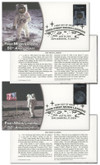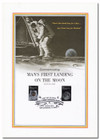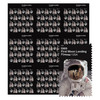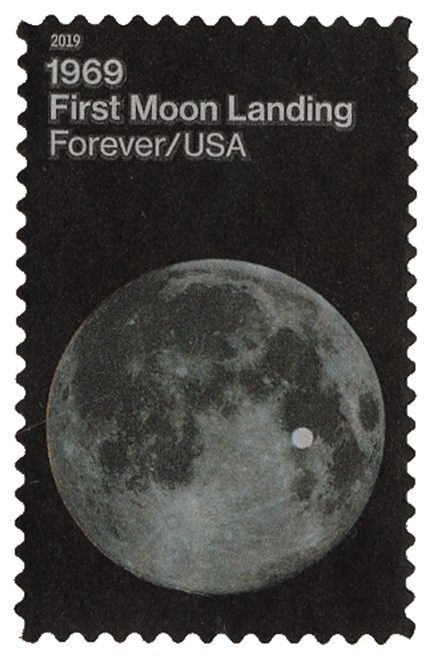
# 5399-5400 - 2019 First-Class Forever Stamp - First Moon Landing
US #5399-5400
2019 First Moon Landing
• Issued in honor of the 50th anniversary of the First Moon Landing
Stamp Category: Commemorative
Value: 55¢ First Class Mail Rate (Forever)
First Day of Issue: J uly 19, 2019
First Day City: Cape Canaveral, Florida
Quantity Issued: 60,000,000
Printed by: Banknote Corporation of America
Printing Method: Offset
Format: Panes of 24
Tagging: Phosphor Tagged Overall
Why the stamps were issued: To celebrate the astronauts who made history in 1969 during the First Moon Landing.
About the stamp designs: One pictures a photograph of Buzz Aldrin in his spacesuit on the Moon. The photograph was taken by fellow Apollo 11 astronaut Neil Armstrong. The second stamp pictures a photograph of the Moon taken in 2010 by Gregory H. Revera. A dot has been added to indicate the landing site of the lunar module in the Sea of Tranquility.
First Day City: The First Day of Issue Ceremony was held at Kennedy Space Center Visitor Complex in Cape Canaveral, Florida.
History the stamp represents: On May 25, 1961, President John F. Kennedy challenged American scientists to land a man on the Moon. While Kennedy did not live to see his vision realized, it was accomplished in just eight years.
Fittingly, Apollo 11 was launched from the Kennedy Space Center in Florida on July 16, 1969. Among the items astronaut Neil Armstrong carried with him was a piece of wood from the Wright brothers’ 1903 plane, to show how far aviation had advanced.
On July 20, Armstrong and Buzz Aldrin landed on the lunar surface while Michael Collins orbited the Moon. Back on Earth, a record 600 million people watched as Armstrong took the first steps on the Moon. In addition to collecting samples, setting up equipment, and conducting experiments, the astronauts left behind a plaque that read, “Here men from the planet Earth first set foot upon the Moon. July 1969 A.D. We came in peace for all mankind.” After returning to Earth, they were honored with parades, a world tour, and the Presidential Medal of Freedom. The mission has also been honored on several US stamps, including a set for the 50th anniversary in 2019.
The Moon landing was a pivotal event of the century. It was a major technological feat and ushered in a new era in space cooperation in which the US collaborated with Space Race rivals, the Soviet Union.
US #5399-5400
2019 First Moon Landing
• Issued in honor of the 50th anniversary of the First Moon Landing
Stamp Category: Commemorative
Value: 55¢ First Class Mail Rate (Forever)
First Day of Issue: J uly 19, 2019
First Day City: Cape Canaveral, Florida
Quantity Issued: 60,000,000
Printed by: Banknote Corporation of America
Printing Method: Offset
Format: Panes of 24
Tagging: Phosphor Tagged Overall
Why the stamps were issued: To celebrate the astronauts who made history in 1969 during the First Moon Landing.
About the stamp designs: One pictures a photograph of Buzz Aldrin in his spacesuit on the Moon. The photograph was taken by fellow Apollo 11 astronaut Neil Armstrong. The second stamp pictures a photograph of the Moon taken in 2010 by Gregory H. Revera. A dot has been added to indicate the landing site of the lunar module in the Sea of Tranquility.
First Day City: The First Day of Issue Ceremony was held at Kennedy Space Center Visitor Complex in Cape Canaveral, Florida.
History the stamp represents: On May 25, 1961, President John F. Kennedy challenged American scientists to land a man on the Moon. While Kennedy did not live to see his vision realized, it was accomplished in just eight years.
Fittingly, Apollo 11 was launched from the Kennedy Space Center in Florida on July 16, 1969. Among the items astronaut Neil Armstrong carried with him was a piece of wood from the Wright brothers’ 1903 plane, to show how far aviation had advanced.
On July 20, Armstrong and Buzz Aldrin landed on the lunar surface while Michael Collins orbited the Moon. Back on Earth, a record 600 million people watched as Armstrong took the first steps on the Moon. In addition to collecting samples, setting up equipment, and conducting experiments, the astronauts left behind a plaque that read, “Here men from the planet Earth first set foot upon the Moon. July 1969 A.D. We came in peace for all mankind.” After returning to Earth, they were honored with parades, a world tour, and the Presidential Medal of Freedom. The mission has also been honored on several US stamps, including a set for the 50th anniversary in 2019.
The Moon landing was a pivotal event of the century. It was a major technological feat and ushered in a new era in space cooperation in which the US collaborated with Space Race rivals, the Soviet Union.


















